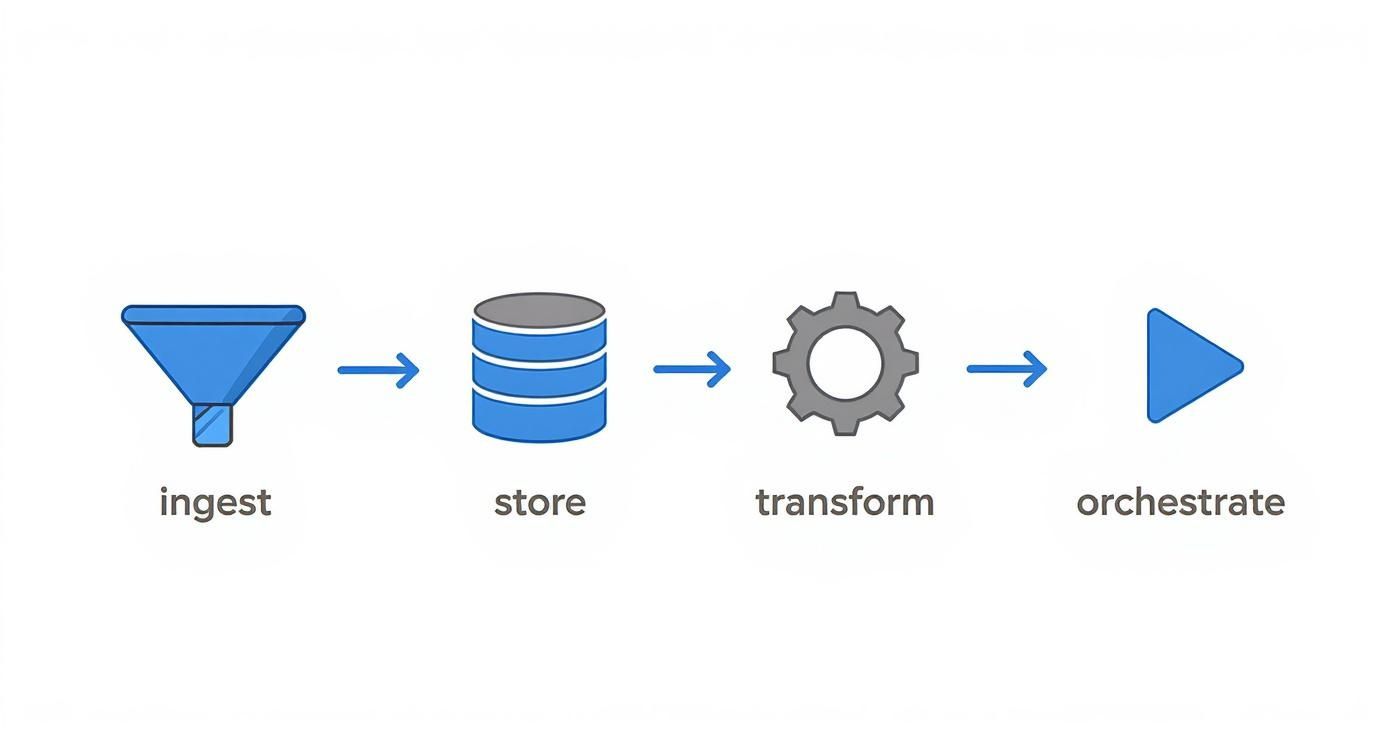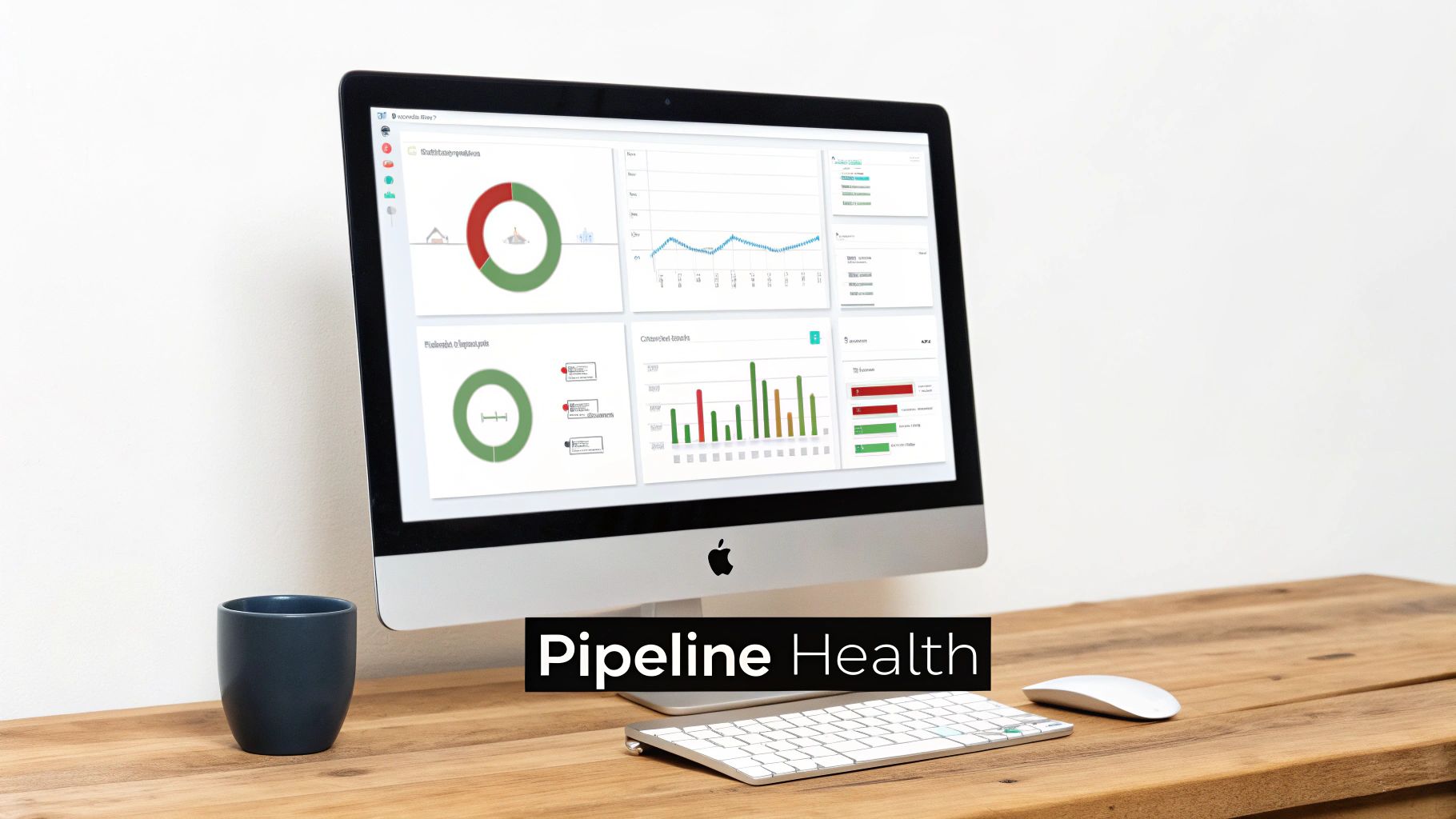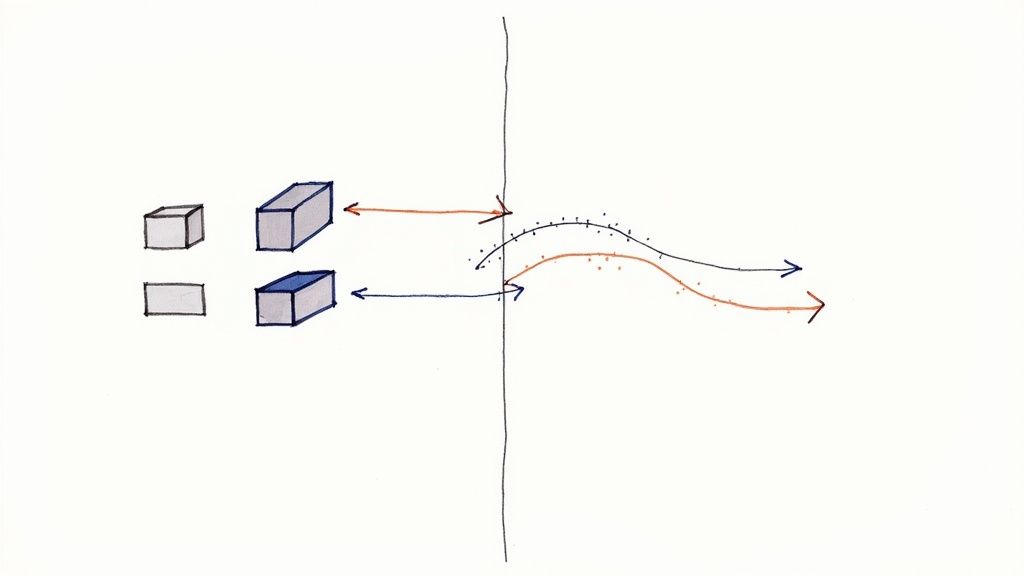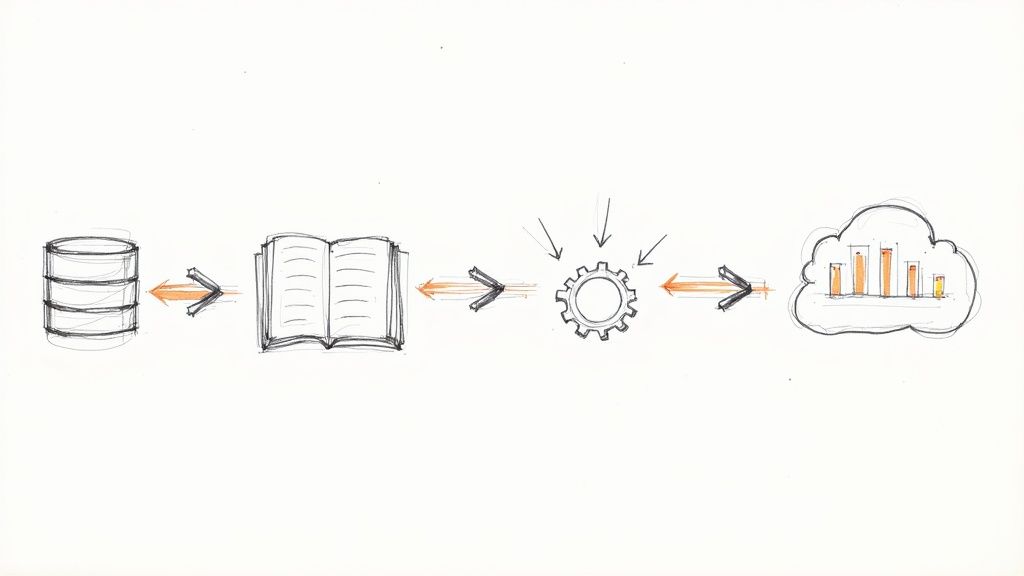automate data pipeline: build robust, efficient workflows
Learn how to automate data pipeline with proven strategies, tools, and architecture tips to design scalable, reliable data workflows.
To automate a data pipeline is to build a self-operating system that handles all the heavy lifting of ingesting, transforming, and loading data without anyone needing to touch it. It’s about swapping out those tedious, manual tasks—the ones that are just begging for errors—for a smooth, reliable workflow. The end goal? Fresh, accurate data is always on tap for anyone who needs it for analysis or decision-making.
Why Automating Your Data Pipeline Is a Game Changer

Let's be honest, manual data processes are a huge bottleneck. They're slow, they break easily, and they suck up your engineering team's precious time. Every time a schema changes or an API key expires, an engineer has to drop everything to go fix a broken script. This constant firefighting doesn't just delay reports; it kills innovation.
When you automate your data pipeline, you’re moving from a fragile, hands-on process to a resilient, autonomous one. For any business that wants to scale its data operations, this isn't just a nice-to-have; it's fundamental.
The True Cost of Manual Pipelines
The problems with sticking to manual pipelines go way beyond just being a hassle. These old-school methods bring hidden costs that silently sabotage your business. For instance, a simple data entry mistake or a misconfigured transformation can corrupt your business intelligence, leading executives to make bad calls based on bad data.
On top of that, the operational overhead is massive. Engineers burn hours just watching jobs run, restarting failed tasks, and double-checking data integrity. It's low-value work that keeps them from building new products or improving core systems. The opportunity cost here is just staggering. You can dive deeper into the specific benefits of leaving manual work behind by exploring the advantages of automating ETL processes.
The table below breaks down the real-world impact of sticking with manual processes versus embracing automation.
MetricManual Data PipelineAutomated Data PipelineData LatencyHours or days; data is often stale.Seconds or minutes; near real-time data access.Error RateHigh due to human intervention and complex steps.Near-zero with built-in validation and retries.Engineer Time50-70% spent on maintenance and firefighting.<10% spent on maintenance; focus is on innovation.ScalabilityPoor. Adding new sources requires significant effort.Excellent. Scales to handle new data sources and volumes easily.Decision-MakingReactive, based on outdated historical data.Proactive, driven by fresh, up-to-the-minute insights.
As you can see, the difference isn't just technical—it's strategic. Automation directly enables a more agile and data-informed business.
Unlocking Key Business Advantages
Switching to an automated data pipeline delivers immediate, concrete benefits you can feel across the entire company. Think of it less as a tech upgrade and more as a strategic move that fuels growth.
Here’s what you stand to gain:
- Dramatically Improved Data Accuracy: Automation cuts out human error, which means your data is cleaner and more trustworthy for all your analytics.
- Faster Time-to-Insight: Data gets to stakeholders much quicker. This shrinks the gap between an event happening and you being able to act on it.
- Built-in Scalability: An automated system can easily handle more data from more sources without you needing to throw more people at the problem.
- Freed-Up Engineering Talent: When you take pipeline maintenance off your engineers' plates, they can finally focus on high-impact projects that actually move the needle.
The core idea is simple: automation lets your team build systems that work for them, not the other way around. It turns data management from a constant headache into a reliable, strategic asset.
The market is clearly heading in this direction. The global demand for these kinds of solutions is set to grow from an expected $7.0 billion market in 2025 to $13.4 billion by 2033. This explosion in growth just highlights how critical it is for businesses to get their data handling right.
Designing a Resilient Automated Pipeline

Automating a data pipeline is about more than just scripting a few tasks together. To do it right, you need a solid architectural blueprint. A well-designed pipeline can weather the inevitable storms—network hiccups, API timeouts, corrupted files—and recover gracefully without someone having to jump in and fix it manually. This resilience is what separates a fragile, high-maintenance script from a dependable, enterprise-grade system.
Building this foundation means getting a few key design principles right from the start. These aren't just buzzwords; they're the practical guardrails that keep your data flowing, even when things go wrong.
Core Principles for a Bulletproof Design
If you take away only two concepts from this section, make them idempotency and observability. I've seen more pipelines fail from a lack of these two things than anything else.
Idempotency is a fancy way of saying that running a process multiple times has the exact same result as running it just once. This is a lifesaver. When a task fails halfway through, you can just rerun it without the fear of creating duplicate records or other nasty side effects.
Observability, on the other hand, is all about knowing what's happening inside your pipeline. This is so much more than basic logging. It's about having the right metrics, logs, and traces to quickly figure out why something broke or, even better, spot a bottleneck before it brings everything to a halt.
Of course, building and maintaining these systems isn't a solo sport. You'll need a solid team, and it's worth taking the time for mastering DevOps team roles and responsibilities to ensure everyone knows their part.
An idempotent pipeline doesn't fear retries. It's designed for a world where failures are not an exception but an expectation. This mindset shift is fundamental to building truly automated, self-healing systems.
Choosing the Right Architectural Pattern
There's no one-size-fits-all pipeline architecture. Your choice will come down to your specific needs, and the two main patterns you'll run into are batch and stream processing. Getting this decision right upfront will save you a world of pain later.
Batch Processing is the classic approach. You gather up data over a period and process it in one big chunk.
- Best for: When you don't need up-to-the-second data. Think nightly financial reports, weekly sales summaries, or end-of-month inventory counts.
- Real-world example: A retail company collects all of its transaction logs throughout the day. At midnight, a job kicks off to process them all at once, calculating total sales for each store. The data is a day old, but it's efficient for massive volumes.
Stream Processing is the opposite; it processes data in real-time as it arrives, usually one event at a time.
- Best for: Use cases where immediate action is critical. This includes real-time fraud detection, live monitoring of website clicks, or analyzing data from IoT sensors.
- Real-world example: A credit card company's system analyzes every single transaction the moment it happens. It can spot a fraudulent pattern and block the purchase within milliseconds, preventing theft before it's complete.
Your choice here has huge implications for the tools you'll use, your infrastructure costs, and the overall complexity of the project.
Integrating Governance and Security from Day One
Here’s a hard-earned lesson: data governance and security are not afterthoughts. You can't just sprinkle them on at the end. They have to be baked into the design of your pipeline from the very beginning. If you don't, you're signing up for costly rework, compliance headaches, and gaping security holes.
This is what it should look like in practice:
- Data Lineage: You need to be able to trace where your data came from, what transformations were applied, and where it ended up. This is non-negotiable for debugging and auditing.
- Access Control: Use role-based access control (RBAC) to set clear, automated rules for who can touch what data at each stage.
- Encryption: All data needs to be encrypted, period. That means in transit (as it moves between systems) and at rest (when it's sitting in a database or data lake).
- Data Quality Checks: Build automated validation steps directly into the pipeline. These checks should catch and quarantine bad data before it can poison your downstream analytics and reports.
When you embed these practices into your architecture, your pipeline becomes more than just efficient—it becomes trustworthy, secure, and compliant. This kind of foresight is what turns a simple project into a long-term strategic asset for the business.
Choosing Your Data Pipeline Automation Stack
Stepping into the world of data tools can feel like walking into a massive, noisy marketplace. Countless vendors are all shouting that they have the best solution, and picking the right technology to automate your data pipeline is a huge challenge. If you choose wrong, you can get locked into expensive contracts, create a mountain of technical debt, and ultimately slow your entire team down.
The secret is to cut through that noise and build a practical framework for making your decision. Instead of getting mesmerized by the latest shiny tool, let's break the stack down into the fundamental jobs it needs to do. A successful automated pipeline really only needs to handle four core functions. Understanding these gives you a clear map for your evaluation.
The Four Pillars of an Automation Stack
Every robust data pipeline, whether it’s a simple one or a sprawling enterprise system, relies on technologies that perform these four distinct roles:
- Ingestion: This is your pipeline's front door. Ingestion tools are all about pulling data from your various sources—SaaS apps, production databases, event streams—and getting it into one central location.
- Storage: Once you’ve got the data, it needs a place to live. This is your data warehouse or data lake, the central repository where all your raw and processed data is stored for analysis.
- Transformation: Raw data is rarely useful on its own. This is where transformation tools come in. They’re responsible for cleaning, modeling, joining, and aggregating your data to get it ready for business intelligence and analytics.
- Orchestration: Think of this as the conductor of your data orchestra. Orchestration tools manage the workflows, schedule jobs, handle dependencies, and make sure every piece runs in the right order, at the right time.
Thinking about your stack in these distinct layers really simplifies the selection process. It lets you evaluate tools based on how well they do one specific job, rather than trying to find a mythical all-in-one solution that does everything poorly. For a deeper dive into how these components fit together, check out our guide on different data pipeline architectures.
Aligning Your Stack with Your Reality
Okay, let's get practical. The "best" tool stack is always the one that fits your specific situation. What works for a five-person startup with a shoestring budget is going to be completely wrong for a global enterprise with a massive data engineering team.
Your decision should be guided by four critical factors:
- Data Volume and Velocity: Are you dealing with gigabytes or petabytes? Do you need data updated hourly, or does it need to be available in milliseconds? High-volume, high-velocity data demands a much more robust and scalable stack.
- Team Skills: Be honest about your team's capabilities. Do you have a team of seasoned data engineers who love writing custom Python and SQL, or are you leaner and more reliant on business analysts who prefer low-code interfaces?
- Budget: Costs can swing wildly, from a few hundred dollars a month for managed services to tens of thousands for enterprise licenses and the cloud infrastructure to run them. Your budget will immediately narrow down your options.
- Speed to Market: How quickly do you need to start getting value from your data? A managed, low-code stack can get you up and running in days, while a custom-built solution might take months of engineering effort.
A common mistake is choosing tools based on what's popular rather than what's practical. I've seen startups choose a complex, enterprise-grade tool like Spark for simple transformations—it's like using a sledgehammer to crack a nut. It just creates unnecessary complexity.
To help you navigate this, I've put together a table breaking down the major tool categories and what to look for in each.
Key Automation Tool Categories and Considerations
This table is a quick guide to help you evaluate and select the right tools for your data pipeline automation stack. Think of it as a starting point for your research.
Tool CategoryPopular ToolsPrimary Use CaseKey Selection CriteriaIngestionFivetran, Airbyte, StreamkapMoving data from sources (APIs, DBs) into a centralized storage system.Breadth of connectors, CDC support, scalability, pricing model, latency.StorageSnowflake, BigQuery, DatabricksStoring and providing fast query access to large volumes of structured and semi-structured data.Scalability, query performance, cost management features, ecosystem integrations.Transformationdbt, Coalesce, Apache SparkCleaning, modeling, and preparing raw data for analytics and BI.SQL vs. code-based, ease of testing/deployment, collaboration features, integration with storage.OrchestrationApache Airflow, Prefect, DagsterScheduling, monitoring, and managing complex data workflows and dependencies.Code-first vs. UI-driven, monitoring/alerting, error handling, community support.
Ultimately, the goal is to build a cohesive stack where each tool plays to its strengths. Don't be afraid to mix and match managed services with open-source components to get the right balance of control, cost, and convenience for your team.
Contrasting Scenarios: Two Different Stacks
To really bring this to life, let's imagine two very different companies building out their automation stack.
Scenario A: The Agile Startup
A small e-commerce startup needs to quickly analyze customer behavior. Their team is small, their budget is tight, and they need insights yesterday.
- Ingestion: Fivetran or Airbyte Cloud (Managed, low-code connectors)
- Storage: Snowflake or BigQuery (Pay-as-you-go, scalable warehousing)
- Transformation: dbt Cloud (SQL-based and easy for analysts to learn)
- Orchestration: The built-in schedulers in Fivetran and dbt Cloud are enough to get started.
This stack is all about speed and simplicity. It uses managed services to slash the engineering overhead, allowing a small team to build a powerful pipeline without getting bogged down in infrastructure. When they pick their tools, they should prioritize enhanced integrations and robust data filtering capabilities to make sure they can connect all their SaaS apps without any fuss.
Scenario B: The Established Enterprise
A large financial institution needs maximum control, security, and customization for its complex compliance reporting. They have a large, skilled engineering team and a significant budget.
- Ingestion: Custom Kafka consumers or a self-hosted Airbyte instance.
- Storage: A self-managed data lake on AWS S3 or Azure Data Lake Storage.
- Transformation: Apache Spark (For large-scale, complex data processing).
- Orchestration: Apache Airflow or Prefect (For intricate, code-based workflow management).
This stack prioritizes control and customizability over ease of use. It gives the enterprise the power to fine-tune every single aspect of the pipeline, but it demands a much larger investment in engineering talent and infrastructure.
The explosive growth in this market shows just how critical these systems have become. The data pipeline tools market is projected to hit $14.76 billion by 2025 and is expected to surge to $48.33 billion by 2030, according to research from Integrate.io. That's a clear signal that investing in the right automation stack is no longer optional—it’s essential.
Getting Real-Time Data with Change Data Capture
In today's fast-moving business environment, waiting on a nightly batch job for fresh data just doesn't cut it anymore. Decisions are made in minutes, not days. If you want to truly automate a data pipeline that can keep up, you have to move beyond old-school bulk loading. This is where Change Data Capture (CDC) comes into play.
At its core, CDC is a set of design patterns for tracking and capturing data changes as they happen in a source database. Instead of constantly dumping and reloading entire tables—which is incredibly inefficient—CDC zeroes in on just the INSERTs, UPDATEs, and DELETEs. This approach is not only lighter on your systems but also opens the door to building powerful, event-driven data flows.
This infographic lays out how CDC fits into a modern data stack, typically right at the beginning of the ingestion process.

As you can see, CDC is the engine that captures real-time events from sources, feeding them through the pipeline for storage, transformation, and orchestration, ultimately delivering up-to-the-minute insights.
Breaking Down the Common CDC Patterns
The method you choose for CDC matters—a lot. Your decision will directly impact performance, complexity, and the reliability of your entire pipeline. Let's walk through the main patterns you'll run into.
Log-Based CDC
This is widely seen as the gold standard, and for good reason. Log-based CDC works by reading the database's native transaction log (like the Write-Ahead Log in PostgreSQL or the binary log in MySQL). This log is a highly efficient, low-level record of every single change made.
- Upsides: It has a minimal performance hit on your source database. You get everything—including deletes—captured accurately and in the correct order.
- Downsides: Setup can be tricky. It often requires specific database permissions and a bit of configuration know-how to get it running smoothly.
Trigger-Based CDC
Here, you place database triggers directly on your source tables. These triggers automatically fire whenever a row is inserted, updated, or deleted, copying the changed data into a separate "shadow" table.
- Upsides: It’s relatively simple to implement with standard SQL. Most database developers can get this up and running pretty quickly.
- Downsides: Triggers add overhead to every single transaction. On a busy production database, this can lead to a noticeable slowdown.
Query-Based CDC
This is the most basic approach. It essentially involves polling the source table on a schedule, looking for a last_updated_at timestamp or an auto-incrementing ID to spot new or changed rows.
- Upsides: Super easy to set up. You don't need any special database features.
- Downsides: This method is notoriously bad at capturing
DELETEs. It can also miss updates if multiple changes happen between your polling intervals, and it puts a constant, repetitive query load on your source database.
For almost any serious use case that demands accuracy and low impact, log-based CDC is the way to go. It treats database changes as a true stream of events, which is the foundation of a modern, real-time data pipeline.
Real-World Example: PostgreSQL CDC to a Data Warehouse
Let's imagine you're running a busy e-commerce site on a PostgreSQL database. You need to get every new order, customer update, and inventory change into your Snowflake data warehouse for the analytics team—and they need it now. A manual export is a non-starter; this process has to be automated and nearly instant.
Log-based CDC is the perfect fit here. Here's a high-level look at how it would work:
- The Initial Snapshot: First, you'd take a one-time, consistent snapshot of your key tables (
orders,customers,products, etc.) and load that historical data into Snowflake. This "seeds" the warehouse, giving you a complete baseline to work from. - Streaming the Changes: With the snapshot complete, a CDC tool (like Debezium or a managed service) connects to PostgreSQL's logical replication slot. It starts tailing the transaction log from the exact point the snapshot finished, so you don't lose or duplicate a single event.
- Delivering to the Warehouse: As the tool reads
INSERT,UPDATE, andDELETEevents from the log, it converts them into a standard format (like JSON) and streams them to a message queue or directly into Snowflake's ingestion layer, like Snowpipe.
This creates a continuous, low-latency data flow. But what about the inevitable changes developers make? A major challenge to plan for is schema evolution. For instance, what happens when someone adds a loyalty_tier column to the customers table? A good CDC solution will detect that schema change automatically and propagate it to the target warehouse without breaking the pipeline.
For a deeper dive into the nuts and bolts, you can learn how to implement change data capture without complexity.
Monitoring and Maintaining Your Automated Pipeline

It’s easy to think that once you've automated a data pipeline, your work is done. But a truly solid system is never "set it and forget it." Think of it as a living system—it needs care and feeding to stay reliable, efficient, and cost-effective over the long haul.
Dropping the ball at this stage is a classic mistake. I've seen it happen countless times: pipelines develop silent failures, data quality slowly degrades, and costs creep up without anyone noticing. To avoid this, you need a good DataOps mindset focused on three things: observability, alerting, and proactive maintenance. These are the pillars that keep your pipeline delivering real value, year after year.
Building Comprehensive Observability
You can't fix what you can't see. Observability is all about instrumenting your pipeline so you can understand what’s happening inside it from the outside. This goes way beyond a simple "pass/fail" status check; it gives you the context you need to debug issues fast. A good observability setup is always built on three types of data.
- Logs: These are the play-by-play event records from every component in your pipeline. When a transformation job breaks, a detailed error log should tell you exactly which line of code is the culprit and why.
- Metrics: Think of these as your pipeline's vital signs—numerical measurements of its performance over time. Key metrics you should always track include data latency (how fresh is it?), throughput (how much is flowing through?), and error rates.
- Traces: A trace is incredible for debugging. It follows a single piece of data on its entire journey through the pipeline, making it easy to spot bottlenecks, like a single slow API call that’s gumming up the works.
Putting this in place isn't just a technical task; it's a strategic one. When a stakeholder asks why a number looks off in a report, good observability lets you trace that data point all the way back to the source, giving you a clear, auditable answer.
Setting Up Meaningful, Actionable Alerts
With good observability feeding you data, the next move is to build alerts that tell you when to pay attention. But there’s a fine line between a helpful alert and just creating noise. The goal is to avoid alert fatigue, where your team gets so many notifications they just start ignoring them.
A truly great alert is specific, contextual, and tells you what to do. A generic "Pipeline failed" message is useless. A much better alert is: "Orders pipeline failed at the payment_processing transform step due to a schema mismatch. 3,450 records were affected. Do not rerun until source schema is verified." This tells the on-call engineer exactly where to look and what not to do first.
A pipeline that screams about every minor hiccup is just as bad as a silent one. Your alerting strategy should focus on notifying humans only when human intervention is actually required.
My advice is to focus your alerts on symptoms, not causes. An alert on high data latency is far more valuable than one on high CPU usage. The latency is the actual business problem; high CPU is just one of many potential reasons for it.
Proactive and Preventative Maintenance
The absolute best way to handle pipeline failures is to stop them from happening in the first place. Proactive maintenance is about regularly checking on your system's health and fixing small issues before they blow up into major outages. This mindset is at the heart of any durable plan to automate data pipeline workflows.
This trend is everywhere. The global industrial automation market is on track to hit $226.8 billion by 2025. It’s a clear signal that businesses are investing heavily in systems that can self-diagnose and maintain themselves. You can get a broader view of how automation is reshaping industries from Thunderbit.
For your pipeline, this means a few key activities:
- Automated Data Quality Checks: Build tools like Great Expectations or dbt tests directly into your workflow. They can automatically check your data against rules you define (e.g., a
user_idcan never be null) and halt the pipeline if bad data gets in. - Dependency Management: Your pipeline depends on APIs, libraries, and other services. Keep them updated. This patches security holes and often gives you free performance boosts.
- Cost Monitoring: Cloud costs can get out of hand fast. Set up dashboards and alerts to watch your compute and storage spending, and keep an eye out for any sudden spikes that might point to an inefficient process.
When you combine deep observability with smart alerting and a proactive maintenance schedule, you turn your automated pipeline from a fragile piece of code into a resilient, trustworthy data asset.
Frequently Asked Questions
When you start automating a data pipeline, questions are going to come up. That’s perfectly normal. You're making big decisions about technology, costs, and the long-term health of your data stack, so it pays to think things through.
Here are some of the most common questions we hear from teams just like yours, along with some straight-ahead answers to help you move forward.
How Do I Handle Schema Changes Automatically?
Ah, schema evolution—the silent killer of data pipelines. One minute everything is running smoothly, and the next, a developer adds a new column to a production table, and your entire pipeline grinds to a halt. Manually fixing this every single time just isn't sustainable.
The answer here is to use tools with automated schema drift handling. This isn't a "nice-to-have" feature; it's a necessity for any serious automated pipeline. Modern data ingestion platforms are designed for this exact problem. When they spot a change at the source—a new column, a different data type, even a deleted field—they can automatically mirror that change in your destination.
Think about it this way: a good Change Data Capture (CDC) tool sees an ALTER TABLE event in the database transaction log. Instead of panicking, it simply issues a corresponding ALTER TABLE command in your Snowflake or BigQuery environment before it tries to send over the new data. Just like that, you’ve avoided a failure, and your pipeline is more resilient without you lifting a finger.
What's the Best Way to Manage and Control Costs?
It's true, an automated data pipeline can rack up a surprising cloud bill if you’re not paying attention. But the solution isn't to avoid automation. It’s to build in visibility and common-sense controls from day one.
Here are a few strategies that actually work in the real world:
- Right-size your tools. Don't fire up a massive, expensive Spark cluster for a simple data cleaning job. Match the tool's cost and power to the problem you're actually solving.
- Set up monitoring and alerts. Use the tools your cloud provider gives you, like AWS Cost Explorer or Azure Cost Management. Create dashboards and, more importantly, set budget alerts that ping you the second that spending starts to spike.
- Be smart about storage. Not all data needs to be in hot, expensive storage forever. Use data lifecycle policies to automatically shift older, less-used data to cheaper tiers.
One of the biggest hidden costs is just moving data around inefficiently. A platform that uses CDC can slash your expenses by only processing data that has actually changed, instead of needlessly copying entire tables over and over. This simple shift can often lead to a 70-80% reduction in data transfer and processing costs.
Should I Build a Custom Solution or Buy a Managed Service?
This is the age-old "build vs. buy" debate, and there’s no universal right answer. It really boils down to your team’s skills, your budget, and what you want your engineers spending their time on.
Here’s a quick way to think about it:
FactorFavoring Build (e.g., using open-source like Airflow/Kafka)Favoring Buy (e.g., a managed platform like Streamkap)Team SkillsYou have a dedicated team of experienced data engineers.Your team is smaller, or you want to empower analysts.Speed to ValueYou have months to build, test, and deploy.You need a working pipeline in days or weeks.Core BusinessData engineering is a core, unique competency for you.You want to focus engineering resources on your product, not infra.MaintenanceYou have the resources to manage, patch, and scale infrastructure.You prefer a vendor to handle all maintenance and upgrades.
For most companies, the real goal is to get value from data, not to become experts in managing data infrastructure. A managed service from a platform like Streamkap is often the faster, more cost-effective path to that goal. Trying to build from scratch can quickly become a massive distraction that pulls your best people away from your core product.
How Does Automation Affect Data Governance and Compliance?
It’s easy to assume that automation makes governance harder, but in reality, it’s the opposite. A well-built automated pipeline is one of your greatest assets for maintaining strong governance and compliance.
Why? Because automation lets you embed your rules directly into the workflow itself. You stop relying on manual checklists and start relying on code.
In practice, this looks like:
- Automated Data Quality Tests: Your pipeline can automatically validate incoming data against a set of rules, quarantining or flagging records that don't pass muster.
- Centralized Logging and Auditing: Every single action—every transformation, every data load—is automatically logged. This creates a perfect, immutable audit trail for compliance teams.
- Role-Based Access Control (RBAC): Access policies are enforced by the system, not by people, ensuring only authorized users and services can ever touch sensitive data.
When you codify your governance policies, you make compliance repeatable, auditable, and far less vulnerable to human error. Governance stops being a bureaucratic headache and becomes just another reliable, automated part of your operations.
Ready to build resilient, real-time data pipelines without the complexity? Streamkap uses CDC to move data from your databases to your warehouse in milliseconds, with automated schema handling and transformations. See how you can replace brittle batch jobs and get your data where it needs to be, right when you need it. Start your free trial today.



